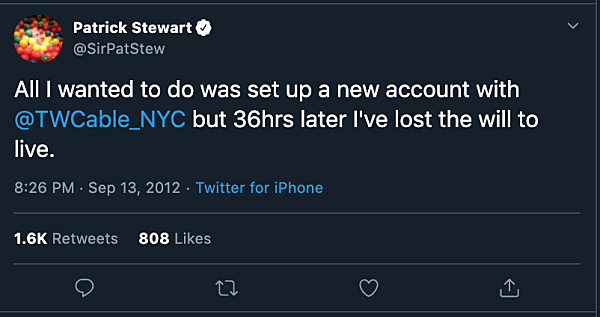Most business owners would rather do anything than respond to a customer complaint. They can be frustrating to read and incredibly time-consuming to defuse and resolve.
Unfortunately, a customer complaint is symptomatic of an issue with your business’s product, service, or level of customer care. A single complaint, when left unaddressed, can snowball into a serious issue that becomes very public—and very expensive.
According to Accenture, a shocking $1.6 trillion is lost by companies in the United States due to customers switching as a result of poor customer service. And if you consider that 70% of the customer journey is dictated by how a customer feels they're being treated, it quickly becomes impossible to ignore that customer complaints can determine whether a brand is meeting its revenue goals.
Not only does a single complaint mean a business loses one consumer’s business—it can also turn into a serious reputation issue that plagues a brand for years. You may be surprised to read, however, that with the right attitude and approach, a customer complaint can be a treasure trove of product innovation and marketing data. Let’s take a closer look at the state of customer complaints:
Why do customers complain?
It’s easy to see things from the one-sided, brand-first perspective. We say to ourselves, “Oh, they’re just the sort of person that likes to complain,” or something to that effect. As brand marketers, we can become defensive of our product, service, or customer care team.
The reality is customer complaints stem from a failure or chink in the “armor” of your brand’s overall offering. Whether that fault originated in manufacturing, the supply chain, or even just in your team’s efforts to communicate with the customer, it still lies with you. Thus, it’s your responsibility to quickly resolve.
Additionally, many customers take to social media to complain. They may not have gotten the response they wanted using offline channels, and sometimes they received no response at all. That’s why some complaints received on social media can seem like an escalation of a smaller issue—because they are.
Understandably, that’s a tough position for your team to be in. However, 78% of consumers said they expect a response within one hour to a complaint posted on Twitter (with respondents saying they’d punish the brand by varying degrees if they failed to do so). Social media has added a new layer of instant gratification to the customer service process. The potential ramifications of this from both a revenue and online reputation perspective are huge.
Take Mercedes-Benz, for example. The luxury car retailer has a long history and is a popular choice for many car enthusiasts. However, it's not immune to reputation issues stemming from a customer complaint gone viral. The complaint, which was filed by a customer at a Chinese dealership, ultimately cost the dealership over $100,000—-as well as legal issues and public embarrassment for its parent company. The woman who complained was quoted as saying she felt like she “wouldn’t be doing something shameful like this if I thought we could still discuss this reasonably.” It was clear she’d tried several other avenues, with no resolution.
If one car dealership has a shady reputation, the whole brand suffers. This is especially true of global brands, which have international news popping up in search results for the brand name on a daily basis. If you were searching for “Mercedes-Benz” and came across the types of articles that flooded Google results around the time of the incident, you would likely choose a competitor with a more favorable reputation.
According to this article on online reputation management services, 25% of a company’s market value is determined by its reputation. While a company’s online reputation is comprised of a few factors, customer feedback can make up a large portion of your customer service and marketing team’s daily workload. They can also shed light on areas of your strategy that need work—and provide valuable opportunities to actually improve your online reputation (believe it or not). But first, you have to take a deep breath, consider the bigger picture, and respond to that pesky complaint.
How to respond to a complaint
It’s never been more convenient for a customer to leave a comment or review detailing a negative experience. How do you respond to customer complaints in a way that preserves their customer loyalty and inspires new business? Try to keep the following in mind:
1. Time is of the essence
We’ve all been on hold for what seems like an eternity. We know how frustrating that can be. In the age of on-demand technology, it’s crucial to leverage modern tools and software to stay on top of brand mentions, manage email inboxes, and help guide consumers through common issues in real-time. Your customers will thank you—Forrester has asserted that 66% of adults feel that valuing their time is the most important thing a business can do to provide them with a good online customer experience.
2. It helps to say you’re sorry
It sounds counterintuitive, but sometimes all a customer wants is to hear that their frustrations are being acknowledged and their concerns are valid. Apologize for the inconvenience, sympathize with them, and above all, let them know that you’re working to give them the outcome they desire.
3. Private channels help to de-escalate
A customer service representative who responds in a public thread—a Tweet, for example—is opening the door for any number of outside influences to impact the outcome of an otherwise successful resolution. Taking your conversation to a private channel helps both the customer and the customer representative engage in more productive dialogue and results in quicker resolutions.
4. Go above and beyond
In the world of customer service, everyone loves an overachiever. Those who are able to give their customers a pleasant experience will reap the rewards exponentially. In fact, 72% of customers would tell six or more people about their positive customer service experience. The potential for new business as a result of stellar customer service is undeniable.
Dealing with a complaint, especially online reviews left on third-party sites, requires a swift, proactive approach. Many brands leverage CRM tools to enhance their sales, marketing, and customer strategies with intentional automation and integration without sacrificing the increased personalization that so many of today’s consumers crave.
Why complaints are a good thing
Let’s repeat that phrase for a moment: customer complaints are a good thing. We’ve long been conditioned to believe the opposite. However, customers are taking the time to tell you about a flaw in your business—and offering you an opportunity to win big by resolving it promptly.
Customer complaints and reviews are also great benchmarks to improve the SEO of ecommerce websites. There are a lot of branded searches that compare companies. So if you can catch complaints early on and address the root issue, they're less likely to impact your ecommerce SEO strategy.
Not only that, but customer feedback data is a big part of any brand’s marketing strategy. When a business understands the changing needs of its consumers, it's better equipped to develop persona-driven strategies for social and the web. This content, in turn, is perfectly positioned to capture new leads and generate conversions. Consider this data point from Salesforce—56% of customers don’t mind sharing their personal information in exchange for better service. This is extremely valuable in an era of ad blindness and spam filters.
Brands leverage this data in a variety of ways, including:
Reviews and Conversion Rate Optimization (CRO) - Third-party reviews are an important purchasing catalyst. They can also make up a significant portion of a brand’s search results. As a badge of trust, you can display reviews and crowdsourced testimonials directly on your site. In this way, you give your brand credibility while keeping as much traffic on your site as possible.
Continuous innovation - Your customers are an incredible resource to crowdsource ideas for continuous product innovation. Try sending out a survey asking people what features they’d like to see, or if there’s a product that they might want to be restocked. How are customers using your products? Are they innovating in ways that would be valuable for you to emulate? (Think to Levi’s ripped jeans as a standout example of brands taking customer innovation into the product line).
Online reputation management - Online reputation is one of the main ways powerful and successful brands market themselves. Displaying reviews, as shown above, is one of the better ways to turn a tarnished reputation around, but why stop there? Consider writing articles for industry publications, managing influencer marketing campaigns, and generating PR brand mentions. All of these bubble up into branded search results that influence a customer’s overall experience and perception of your brand during the purchase funnel.
Content marketing -Your business can develop content aimed at solving a problem held by your target audience. A list of pain points can be easily extrapolated using customer feedback data. These pain points feed personas, which influence the type of content you produce. From blog articles to landing pages to infographics, all content should be extremely targeted and highly optimized. High-quality content combined with a savvy SEO strategy builds brand awareness—which is incredibly important when looking to capture organic search traffic from competitors.
Now that you understand where complaints come from and their impact on a brand, it’s easy to see how feedback from across the spectrum (both positive and negative) can ultimately strengthen the business. In a crowded digital marketplace where customer experience is king, your brand’s ability to navigate and resolve customer complaints—as well as the ability to turn them into fuel for your marketing strategy—will set you apart from the pack.
Have you listened to the newest episode of SmallBizBuzz? Listen below to hear our discussion about success and employee happiness.
— Keap (@KeapGrowing) January 30, 2020
Don't forget to leave us a ⭐ ⭐ ⭐ ⭐ ⭐ review wherever you listen to podcasts. https://t.co/1bpFrY1yuZ pic.twitter.com/9zMMNVng6F







